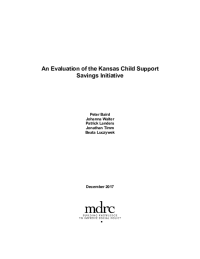An Evaluation of the Kansas Child Support Savings Initiative

The state of Kansas created the Child Support Savings Initiative (CSSI) in 2013 to help parents who owe child support pay off debt that is owed to the state while also saving for their children’s future higher education.[1] The program aims to encourage parents to make qualifying deposits into tax-advantaged college savings plans — 529 accounts — administered by the state. In return, the parents receive matching reductions in their child support debts.
Kansas originally created CSSI only for parents who owed child support debts to the state. When Kansas decided it wanted to expand CSSI to debts owed the parents receiving child support, it needed to find an alternate source of funding to pay off those debts. It was able to do so in 2014 with funding from the W.K. Kellogg Foundation, and under that grant MDRC received a contract to provide technical assistance and conduct an evaluation in conjunction with the expansion.
MDRC applied insights from behavioral science to design and test solutions to address the savings program’s primary challenge, which was that very few of the parents invited to participate ever responded or enrolled. Over several years, Kansas and MDRC conducted two randomized controlled trials to test different methods of outreach and engagement, and made significant changes to the program’s design and operations. While implementation research suggests that some parents found CSSI appealing, the first round of testing saw largely trivial effects and the second round saw none.
These results confirm other research that it is difficult to encourage low- and moderate-income individuals to save money. Parents in child support debt probably face even greater economic challenges than many other low-income people, as they are struggling to make their current child support payments and pay down their child support debts while meeting all their other life obligations. Members of the target population for this study, parents who owed more than $1,000 in child support debt, generally had no income or extremely low incomes.
Although it was challenging for this study to achieve effects, behavioral economics did play an important role for both Kansas and the research team. Both the state and research team have a clearer understanding of the challenges and opportunities related to addressing child support debt and encouraging savings for education. That said, the materials informed by behavioral science developed by the research team largely failed to get parents’ attention, and even when they did, the program might not have been attractive enough and the program materials not able to overcome the gap between intention and taking action. The results of this study suggest that there are limitations in marketing child savings accounts to parents in child support debt and, perhaps, to low-income parents in general.
[1]If a family is receiving Temporary Assistance for Needy Families, then child support payments are used to offset those benefits, and unpaid child support results in debt owed to the state.






